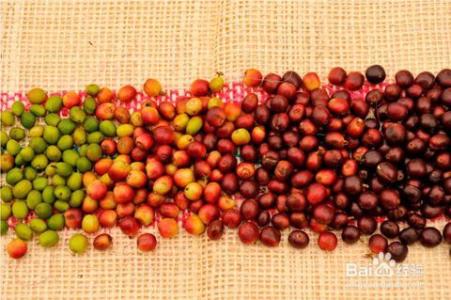Introduction to the planting environment and natural conditions of coffee trees from flowering to fruiting
Introduction to the planting environment and natural conditions of coffee trees from flowering to fruiting
Coffee trees bloom continuously from February to May. Bear fruit after anthesis. The fruit is green. No artificial pollination is needed.
Every March, the branches of the coffee tree will appear white flowers, the petals are spirally arranged, and the heart jumps around the petals. If you take a closer look, you can see that it is really like a small windmill playing in childhood, emitting the fragrance of jasmine flowers; the fruit is oval, berries, crimson, and contains two seeds, that is, the coffee beans we are familiar with.
Coffee trees usually wither after two or three days of flowering and begin to bear fruit after a few months. The fruit is a drupe with a diameter of about 1.5cm. It turns green at first, then turns yellow gradually, and turns red when ripe. It is very similar to cherries, so it is called cherry coffee (Coffee Cherry). It can be harvested at this time.
Coffee trees can blossom for a few years, and the editor will introduce them to you when they blossom and bear fruit. Coffee tree opposite leaves are long oval, smooth leaves, the end of the branch is very long, few branches, and the flowers are white, open at the base of the petiole connecting the branch.
In fact, the Arabs began to grow coffee in 525 BC, and chewing fried coffee beans became popular in the Arab region. In 890 AD, Arab merchants sold coffee beans to Yemen, and Yemenis made coffee beans into drinks for the first time. In the 15th century, coffee was introduced into Europe, Asia and soon into America. By the 18th century, coffee was widely grown in tropical and subtropical regions of the world and became one of the three major drinks in the world. Coffee ranks first among the top three beverages in annual sales, three times as much as cocoa and four times as much as tea. Although coffee has been cultivated in the world for more than 2000 years. However, coffee has been cultivated in China for only a few hundred years. In 1884, Taiwan Province began to introduce coffee.
At the beginning of the 20th century, overseas Chinese brought coffee back from Malaysia to grow in Hainan Province. Later, tropical and subtropical provinces in the south began to grow plant coffee one after another. Although the cultivation time is short, the coffee from Hainan and Yunnan provinces in China has excellent quality and unique charm, so it enjoys a high reputation in the world. After some foreign businessmen buy it at a low price, it is processed and sold to the international market. It has become an expensive world-class drink, especially the small-grain coffee grown in Yunnan Province. Because of the large temperature difference between day and night in Yunnan, it is conducive to the accumulation of substances in it. Therefore, it tastes strong but not bitter, fragrant but not strong, oily and fruity, so it is praised as "the best quality coffee in the world" by coffee merchants at home and abroad.

Important Notice :
前街咖啡 FrontStreet Coffee has moved to new addredd:
FrontStreet Coffee Address: 315,Donghua East Road,GuangZhou
Tel:020 38364473
- Prev

As long as you get the right ideas and promotions, coffee festivals are held every day.
On Good Morning World's official page, in addition to the constantly updated countdown to International Coffee Day and the latest number of participants, you can also see a promotional video edited by many participants: in the lively background music, a Nestle red cup is passed from the hands of white girls to young Indians dressed in sari, and then to Europe, across the Atlantic coast,
- Next

Coffee roasting curve data-coffee hand brewing record table
Coffee roasting curve data-Coffee hand-made record Table Raw beans (Green Coffee) the unbaked beans look green and the color changes with the degree of roasting. Light baking (Light Roast) is the most mild baking method, the appearance is wheat color, after extraction, there is no fragrance, bitter taste, not suitable for drinking cinnamon baking (Cinnamon Roast) mild baking method, the appearance is cinnamon
Related
- Beginners will see the "Coffee pull flower" guide!
- What is the difference between ice blog purified milk and ordinary milk coffee?
- Why is the Philippines the largest producer of crops in Liberia?
- For coffee extraction, should the fine powder be retained?
- How does extracted espresso fill pressed powder? How much strength does it take to press the powder?
- How to make jasmine cold extract coffee? Is the jasmine + latte good?
- Will this little toy really make the coffee taste better? How does Lily Drip affect coffee extraction?
- Will the action of slapping the filter cup also affect coffee extraction?
- What's the difference between powder-to-water ratio and powder-to-liquid ratio?
- What is the Ethiopian local species? What does it have to do with Heirloom native species?

